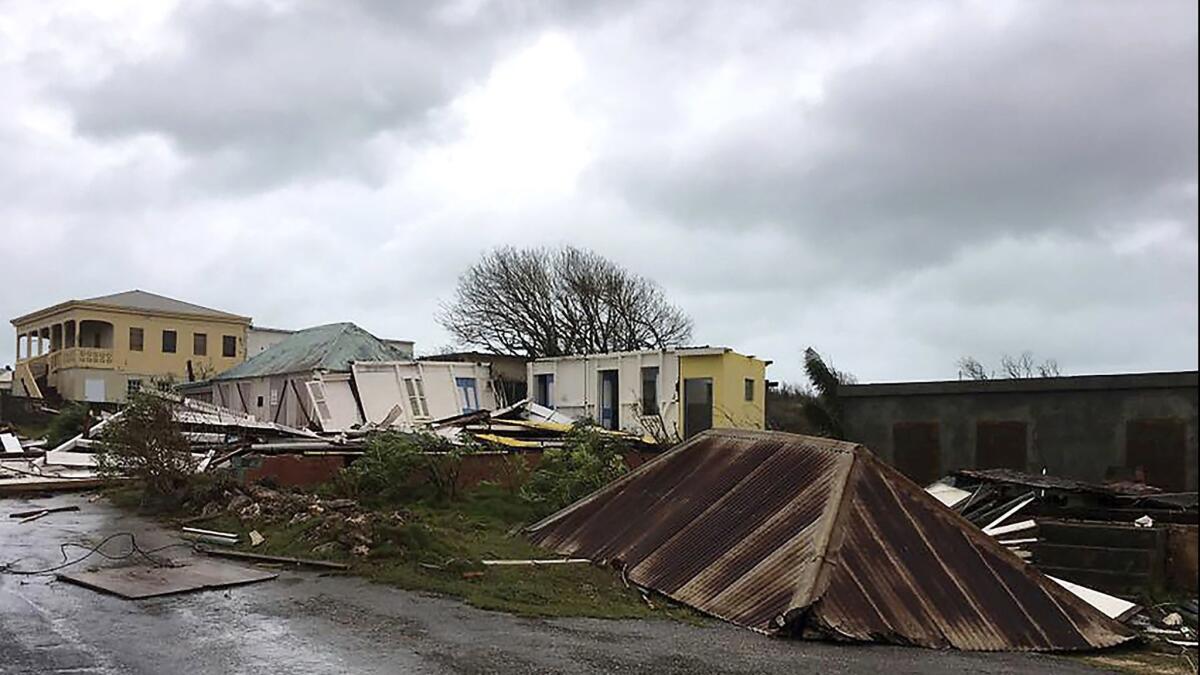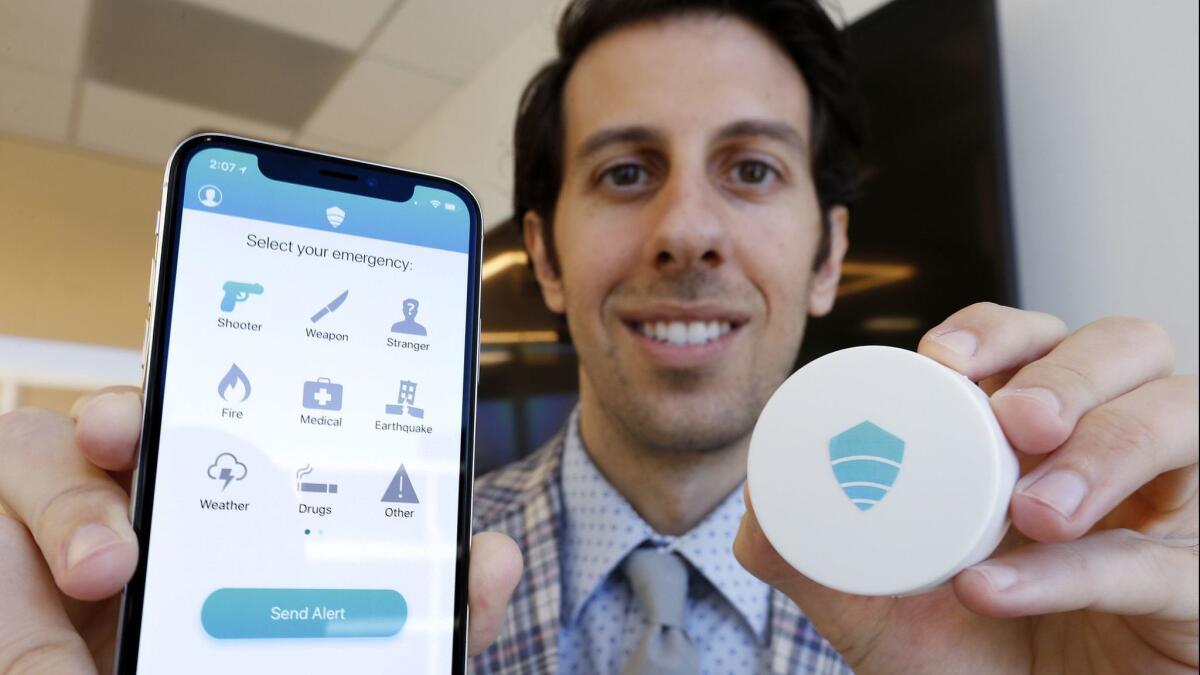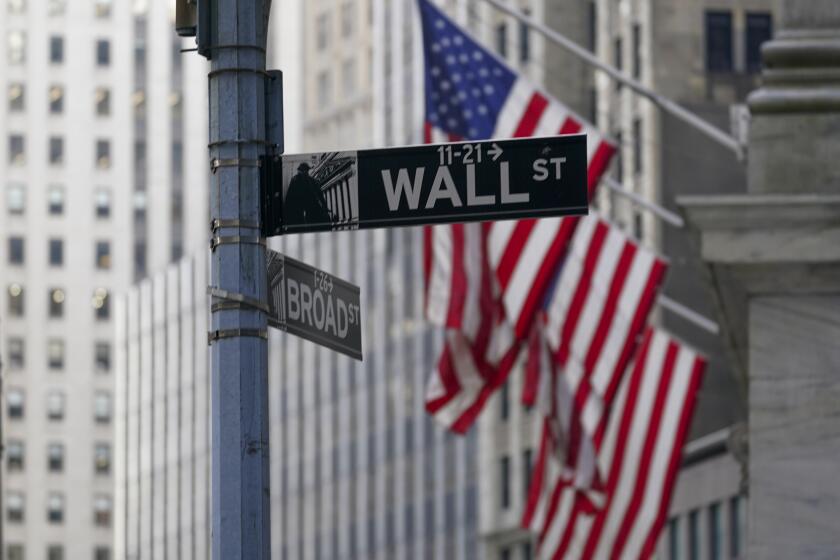Fires, floods and other calamities fuel this app’s popularity

On the morning a fire forced the evacuation of her daughter’s school, Ruth Kobayashi found out about it when her smartphone bleated out the distinctive tone she knows she can’t ignore: the Orange County high school’s app-based emergency communications system.
The app, created by Newport Beach start-up Titan HST, sent her a series of reassuring messages. The fire was small. It was quickly extinguished. The evacuation was precautionary. All of the students were safe.
“It was great because kids don’t always have accurate information in an emergency,” Kobayashi said. “If I was just relying on my daughter to send me a text saying, ‘There’s a fire. They’re making us evacuate,’ you can imagine me thinking that the whole school’s burning down. I didn’t have to go through that.”
Since its release in 2016, Titan HST’s emergency communication system has been embraced by businesses, educators and the medical profession. One reason, customers say, is the system’s reliability.
Another? Americans are hungry for ways to feel safe and well informed. And little wonder, considering:
• In 2016 and 2017, the FBI reported 50 active shooter incidents that left more people dead and wounded than in any previous two-year period.
• U.S. natural disasters caused a record $306.2 billion in damage in 2017, shattering the inflation-adjusted mark of $214.8 billion that had stood since 2005, according to the National Oceanic and Atmospheric Administration.
• The American Psychological Assn.’s most recent Stress in America Survey showed fears over personal safety and terrorism beginning to rival more typical worries about money, work and the economy. The percentage of people citing personal safety as a significant source of stress climbed to 34% in 2017, the highest since the question was first asked in 2008.
One-third of business owners are relying on advanced technologies such as apps, drones, wearable devices and building sensors to support workplace safety, according to Nationwide Insurance’s fourth annual business owner survey, conducted in June. This use of such technology has “become a part of the business ecosystem,” Nationwide Vice President Tony Fenton said.

Vic Merjanian, chief executive of Titan HST, has been riding that wave since founding the company in 2013. In 2016, his company closed seed funding and began signing up clients.
Business has been booming. Most recently, Merjanian said, Titan HST has signed a contract with the Cal State University system, beginning with the chancellor’s office. In April, the company signed a contract valued at $300 million with New York-based Titan Global, an unrelated security firm.
It wasn’t the likeliest of outcomes for a UC San Diego graduate who majored in sociology, earned his law degree from University of San Diego law school and then founded a law practice. He began to wonder how people, rather than suing after an injury, could avoid mishaps in the first place.
“People date from apps, you order food from apps,” Merjanian said. “You do everything from apps, right? So why can’t you get help from an app?”
Merjanian called his company Titan Health & Security Technologies Inc. but he shortened it to Titan HST for marketing and branding.
“We saved our first life within 20 minutes of public deployment,” Merjanian said, recalling how a teacher returned to a science classroom and found a student trying to drink bleach.
Usage has exploded. Merjanian said the system was used 62 million times in 2017, up from 16 million in 2016. The private company doesn’t reveal revenue.
The app, designed for schools, businesses and government agencies, allows users to transmit emergency alerts by picking from a menu of emergency icons on a smartphone or Apple Watch. The system also is accessible through text message, email, the web and social media feeds including Facebook and Twitter. It’s available in multiple languages.
“The first core function is the SOS. So you can select any kind of emergency you have,” Merjanian said.
“Even though everyone is worried about active shooters, 40% of the use of the system is for medical emergencies. So we’re talking about everything from diabetic shock to food allergies,” he said. “A college sorority has used this to alert people at parties if they fear the drinks are being spiked.”

Titan HST has created an app designed to keep people connected and well informed during natural disasters like wildfires, hurricanes and floods. It also does the same for man made incidents, such as active shooter situations. The app is being used b
The app can access a phone’s camera to send visual alerts.
“If people are hiding from a shooter, you can see where they’re hiding and whether they’re injured or not,” Merjanian said. The app shows the location of people who are safe and those who are not, and lists those who have not checked in to report their status.
The technology is still being refined, Merjanian said. The company is adding “mesh networking” to allow a phone to link to nearby phones if cellular towers are down and Wi-Fi isn’t accessible.
Titan recently partnered with Newport Beach-based Exoio to make and market small sensors with a communication range of 30 feet to 1,000 feet to help pinpoint app users’ locations during emergencies. Exoio is the latest technology company started by Shawn Dougherty, co-founder and former chief operating officer of Mophie, the Tustin-based maker of phone charging accessories.
The app’s cost varies by sector, volume and use type, Merjanian said. For schools, the cost starts at $2 a student per year paid by the institution, not parents. Private-sector clients usually pay between $2 and $10 per user per month.
Emergency management consultant Bill Cunningham has made the Titan HST app part of preparedness plans and training he devises for businesses, government agencies and other customers.
Cunningham, chief executive of Irvine-based Building Emergency Response Teams, got to try the app out sooner than expected in early September with some clients on the Caribbean island of Anguilla, including a hotel, as they braced for a direct hit from Hurricane Irma’s 185-mph winds. Cunningham had created a preparedness plan but hadn’t had time for a trial run.
The Titan HST app “helped keep track of everyone to make sure they were safe,” Cunningham said. “It really worked.”
The 23,000-student Newport-Mesa Unified School District has rolled out the app systemwide. It has already gotten quick medical attention for a teacher who had an emergency during a class. It’s also enabled immediate lockdowns when strangers were on campus.
“It has proved to be a fantastic emergency broadcast and communications platform for our schools, our students, our families and our staff,” said Phil D’Agostino, director of student and community services for Newport-Mesa.
David Marcus, campus business manager at West Hills’ De Toledo High School, said the school uses the Titan HST app but hasn’t had a real emergency yet, just lots of practice sessions for when the real thing happens.
Marcus said the app has been useful in non-emergencies, alerting parents that students returning from games or field trips will be arriving late because of heavy traffic.
The technology is designed to resist pranks, employing such things as geo-fencing to prevent someone from declaring a school emergency when they are actually far away from campus.
“There are good control features,” Marcus said. “That’s really important because we didn’t want just anyone sending a message out to our entire school community.”
For more business news, follow Ronald D. White on Twitter: @RonWLATimes
More to Read
Inside the business of entertainment
The Wide Shot brings you news, analysis and insights on everything from streaming wars to production — and what it all means for the future.
You may occasionally receive promotional content from the Los Angeles Times.











